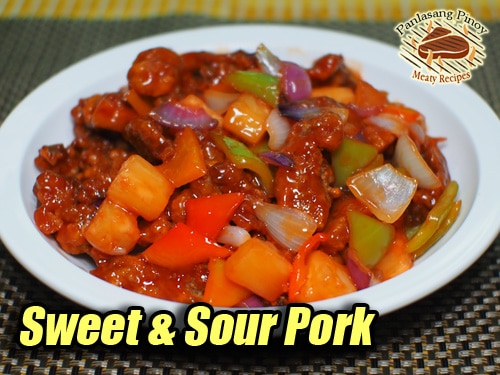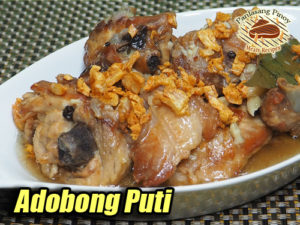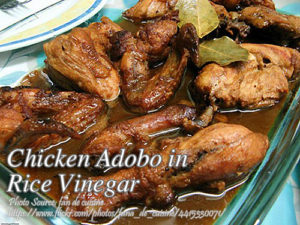Sweet and sour pork is a popular Chinese dish that is also a Filipino favorite dish. This is the reason why in most Chinese restaurant this dish is always present in the menu. This recipe I have here taste like the sweet sour pork in Chowking fast food store because it is more on the sweeter side. I mean the sourness is almost not present in the dish. But if you want it to taste the traditional sweet and sour taste, just add the vinegar which I also included in the recipe but it is only optional. The ingredient that gives it a little sourness is the ketchup specially is you will use tomato ketchup. But banana ketchup is fine if you have a sweet tooth.
A Filipino Favorite with a Chinese Twist
This pork recipe is a beloved Chinese dish that has found a special place in Filipino cuisine. Its popularity is evident as it graces the menu of almost every Chinese restaurant in the Philippines. The allure of this dish lies in its harmonious blend of sweet and tangy flavors, making it a hit among Filipinos who enjoy a delightful balance in their meals. This particular recipe mirrors the taste of the popular pork dish served at Chowking, a renowned fast-food chain in the Philippines, known for its slightly sweeter rendition of the classic dish. While traditional sweet sour pork emphasizes a tangy flavor, this version leans more towards sweetness, with just a hint of sourness from the ketchup used.
A Touch of History
This is a dish that has traveled far and wide from its origins in China. Historically, sweet and sour sauce was used to enhance the flavors of various dishes in ancient China. This method of cooking was popularized in the southern regions, particularly in Guangdong province, where the Cantonese version became a staple. Over time, as Chinese immigrants settled in different parts of the world, they brought their culinary traditions with them. In the Philippines, the dish evolved to cater to the local palate, often incorporating ingredients like banana ketchup, a uniquely Filipino condiment. This adaptation showcases the fusion of Chinese culinary techniques with Filipino tastes, creating a dish that is both familiar and unique.
Preparing the Perfect Pork
To achieve the perfect Chowking style, begin by slicing the pork into half-inch thick pieces along the grain. This ensures the meat remains tender and juicy after cooking. In a bowl, combine the pork slices with soy sauce, garlic powder, and flour. Mix thoroughly until the meat is well-coated, allowing the flavors to penetrate. Let the mixture stand for a few minutes to marinate.
For an added layer of crispiness, coat each piece of marinated pork in cornstarch. This step is crucial as it creates a light, crunchy exterior when fried. Heat cooking oil in a deep pan and fry the pork until golden brown, approximately five minutes. Once cooked, transfer the pork to a colander to drain any excess oil.
Crafting the Signature Sauce
The sauce is the heart of pork dish, and this recipe ensures it delivers that characteristic flavor. In a bowl, combine ketchup, vinegar, brown sugar, salt, cornstarch, and water. Stir the mixture until the sugar is fully dissolved, creating a smooth sauce base. The use of tomato ketchup gives the sauce a slight tang, while the vinegar, though optional, can be added to enhance the sourness if desired.
The Double Fry Technique
For an extra crunch, refry the pork pieces. Heat the cooking oil to high and refry the pork for an additional one to two minutes. This second frying session not only makes the pork crunchier but also locks in the flavors. After refrying, set the pork aside and prepare to stir-fry the vegetables.
Stir-Frying the Vegetables
In a clean pan, heat two tablespoons of oil and stir-fry the bell peppers and onions for about 30 seconds. The brief cooking time ensures the vegetables retain their crispness and vibrant color. Add the pineapple chunks and continue stir-frying for another 30 seconds. The pineapple not only adds sweetness but also a delightful contrast in texture to the dish. Once done, remove the vegetables from the pan and set them aside.
Bringing It All Together
Using the same pan, pour in the prepared sweet and sour sauce. Stir continuously until the sauce thickens to the desired consistency. This thickened sauce will cling beautifully to the pork and vegetables, ensuring every bite is flavorful. Add the cooked pork and vegetables back into the pan, tossing them in the sauce until everything is well-coated.
Serving Suggestions
Turn off the heat and transfer the pork to a serving plate. This dish is best enjoyed hot, served alongside a steaming bowl of rice. The rice not only complements the flavors but also helps balance the richness of the sauce.
A Dish that Bridges Cultures
This popular dish is more than just a meal; it’s a testament to the cultural exchange between China and the Philippines. Each bite tells a story of culinary adaptation and innovation, making it a favorite among Filipinos. Whether you prefer it sweet or with a hint of tanginess, this dish is sure to satisfy your taste buds and leave you craving for more.
How to Cook Sweet and Sour Pork Chowking Style
Ingredients
- 300 grams pork loin or pork shoulder
- 1 tsp. garlic powder
- 1 raw egg beaten
- 1 Tbsp. light soy sauce
- 2 Tbsp. all-purpose flour
- 1/2 cup cornstarch for dredging
- 1/2 cup pineapple chunks
- red and green bell peppers
- 1 red onion
- 1 white onion
- cooking oil for frying and sauteing
For the sweet sour sauce:
- 4 Tbsp. tomato or banana ketchup
- 3 Tbsp. brown sugar
- 2 Tbsp. vinegar optional
- 1 tsp. cornstarch
- 1/2 tsp. salt
- 2 Tbsp. water
Instructions
How to Cook Sweet and Sour Pork Chowking Style
- Slice the pork into 1/2 inch thick along the grain. In an empty bowl, combine pork, soy sauce, garlic powder and flour.
- Mix until the meat is well coated. Let it stand for a few minutes. Then put cornstarch in a deep plate then dip each pork and coat it thoroughly.
- Heat cooking oil in a deep pan and fry the pork until golden brown, about 5 minutes. Then remove from the pan and transfer to colander to drain excess oil.
- To make the sauce: combine ketchup, vinegar, brown sugar, salt, cornstarch and water. Stir until the sugar is dissolved.
- Heat the pan with the cooking oil in high heat and refry the pork for 1 to 2 minutes to make it crunchier. Then remove from oil and set aside.
- In an empty pan, heat 2 Tbsp. of oil and stir fry the veggies (bell peppers and onions) for 30 seconds. Then add the pineapple and stir fry for 30 seconds more. Remove from pan and set aside.
- In the same pan, pour the sweet sour sauce and stir until the sauce is thick. Add the veggies and pork and toss until well coated with the sauce.
- Turn off heat and transfer to a serving plate. Serve hot with cooked rice.
Video
Notes
Cooking Tips:
Achieving Perfect Crunch To ensure your pork pieces are extra crispy, make sure to coat them thoroughly in cornstarch before frying. This creates a light, crispy crust that holds up well to the sweet and sour sauce. Additionally, double frying the pork enhances its crunchiness, making each bite satisfyingly crisp. Balancing Flavors When making the sweet and sour sauce, taste it before adding it to the pork and vegetables. Adjust the balance of sweetness and tanginess by adding more vinegar for a sharper flavor or more sugar for extra sweetness. Remember, the sauce should complement the pork without overpowering its natural flavor. Stir-Frying Vegetables Stir-fry the bell peppers, onions, and pineapple only until they are just tender-crisp. Overcooking the vegetables can lead to a loss of their vibrant colors and textures, which are crucial for the dish's appeal. A quick stir-fry of about 30 seconds ensures they retain their crunch and contribute a fresh contrast to the savory pork.





